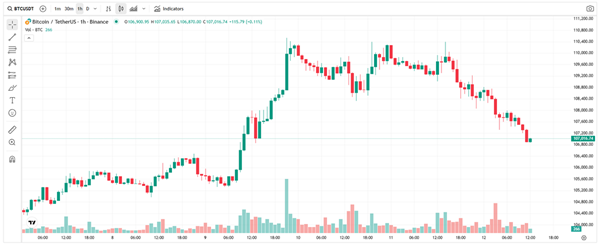Bitcoin pulls back slightly, but institutional money increasingly dominates the market

Bitcoin is trading around $107,000, down about 2% from its intraday high of $110,300 on Wednesday (June 11, 2025). While some investors see this as a short-term “cooling off” signal after the recent surge, the longer-term picture shows that institutional investors are increasingly controlling the market.

Institutions Hold Nearly 1/3 of Total Bitcoin Supply
According to the latest report from Gemini and Glassnode, centralized entities including exchanges, ETFs, public companies, and even governments now hold 30.9% of the total circulating Bitcoin supply. This is a record high, reflecting a deep structural shift in Bitcoin’s ownership structure.
More notably, over 75% of adjusted remittance volume now occurs through centralized platforms such as US spot ETFs, regulated derivatives exchanges, and major CEX exchanges, a significant jump from the 2017-2020 period.
Institutions are no longer just “in” they are dominating
Unlike the early stages when retail investors dominated trading, institutions are now playing a central role in regulating Bitcoin’s liquidity, capital flows, and even price movements.
This is a clear sign that Bitcoin is no longer just a speculative asset, but has become an integral part of the long-term asset strategies of major financial institutions.
Macro factors: inflation declines, Fed easing expectations rise
The latest data from the US shows that the Consumer Price Index (CPI) in May increased by only 0.1%, lower than the expected 0.2%. This boosts expectations that the Federal Reserve (Fed) will start cutting interest rates later this year, a positive factor for risk assets like Bitcoin.
Some analysts have even raised their Bitcoin price target to $200,000 by the end of 2025, based on the assumption that:
Institutional capital inflows will continue to increase;
Monetary policy will become more loose;
The market continues to see a shortage of supply after the April halving.
Why this matters
The current price correction may cause the market to temporarily lose momentum, but the fundamentals are strengthening for a stronger rally in the future. As institutions hold more, control more cash flows, and exert greater influence over liquidity, Bitcoin is moving closer to becoming a mainstream institutional asset.
Bottom line: Bitcoin may be “resting,” but institutional dominance is strengthening, laying a solid foundation for a potential long-term rally.
